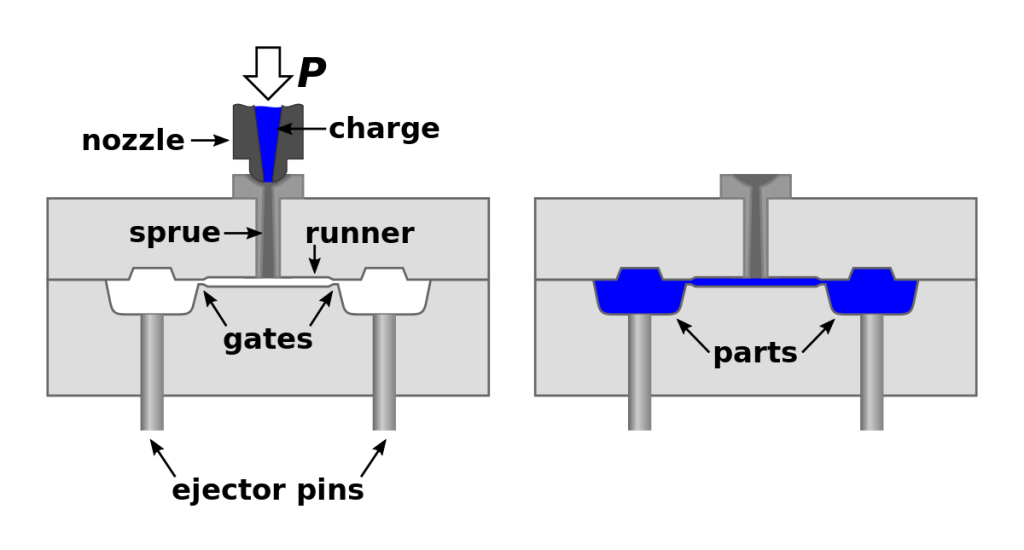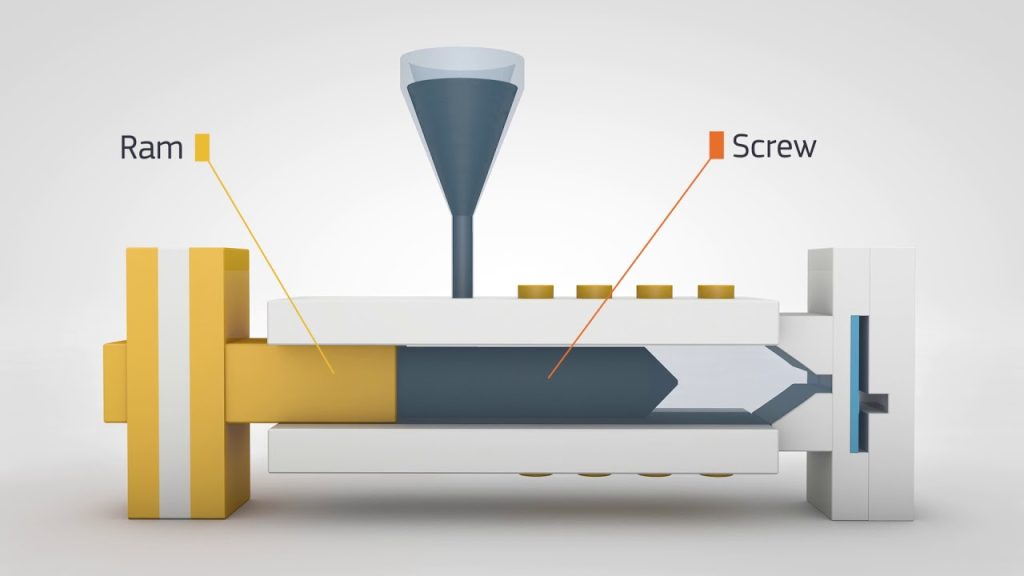Table of Contents
- Frequently Asked Questions
- Is 3D printing cheaper than injection molding?
- What are the advantages of 3D printing over injection molding?
- What are the advantages of injection molding over 3D printing?
- Which is better for prototyping, 3D printing or injection molding?
- Which is better for mass production, 3D printing or injection molding?
The world of manufacturing has seen a tremendous shift in recent years, with the advent of 3D printing technology. This innovative technology is being touted as a game-changer, with many experts claiming that it could revolutionize the manufacturing industry. One of the most common questions asked by manufacturers is whether 3D printing is cheaper than injection molding. In this article, we’ll explore the pros and cons of both methods and try to answer this question once and for all.
3D printing has been gaining popularity in recent years, thanks to its ability to produce complex designs and objects with ease. Injection molding, on the other hand, has been around for decades and is a tried-and-true method for mass production. However, when it comes to cost-effectiveness, both methods have their advantages and disadvantages. In this article, we’ll delve deeper into the cost implications of both methods and help you determine which one is the most cost-effective for your manufacturing needs.
While 3D printing has lower upfront costs and allows for greater design flexibility, injection molding is typically more cost-effective for larger production runs. The cost per unit decreases significantly as the number of units increases with injection molding, whereas 3D printing costs remain relatively constant regardless of the number of units produced. Ultimately, the choice between 3D printing and injection molding depends on the specific needs of the project and the production volume required.
Is 3D Printing Cheaper Than Injection Molding?
When it comes to manufacturing, cost is often a deciding factor in choosing the right method. Two popular methods are 3D printing and injection molding. Both have their advantages and disadvantages, but the question remains – which one is cheaper? In this article, we will compare the two methods and determine which one is more cost-effective.
Cost of 3D Printing
3D printing is a relatively new technology that has gained popularity in recent years. The cost of 3D printing varies depending on the type of printer, material, and complexity of the design. The initial cost of a 3D printer can range from a few hundred dollars to tens of thousands of dollars. The cost of the material used for printing also varies. For example, plastic filament can cost anywhere from $20 to $50 per kilogram, while metal powder can cost upwards of $100 per kilogram.
Despite the initial cost of a 3D printer and materials, 3D printing can be more cost-effective than injection molding for small production runs. This is because there is no need for expensive molds or tooling, which can cost thousands of dollars. Additionally, 3D printing allows for more design flexibility and can be used to create complex geometries that would be difficult or impossible to create using injection molding.
Cost of Injection Molding
Injection molding is a well-established manufacturing method that has been used for decades. The cost of injection molding depends on several factors, including the size and complexity of the part, the quantity produced, and the material used. The biggest expense in injection molding is the cost of the mold or tooling. This can cost anywhere from a few thousand dollars to hundreds of thousands of dollars, depending on the size and complexity of the part.
Injection molding can be more cost-effective than 3D printing for large production runs. This is because the cost of the mold or tooling can be spread out over a larger quantity of parts, reducing the cost per part. Additionally, injection molding can produce parts with a smoother surface finish and greater dimensional accuracy than 3D printing.
Benefits of 3D Printing
Despite its higher initial cost, 3D printing has several benefits that make it an attractive option for certain applications. One of the biggest benefits is its design flexibility. 3D printing allows for the creation of complex geometries that would be difficult or impossible to create using injection molding. Additionally, 3D printing allows for rapid prototyping and iteration, which can save time and money during the product development process.
Another benefit of 3D printing is its ability to produce small production runs cost-effectively. Since there is no need for expensive molds or tooling, 3D printing can be a more affordable option for producing small quantities of parts. This is particularly useful for companies that need to produce custom or one-off parts.
Benefits of Injection Molding
Injection molding also has several benefits that make it a popular choice for manufacturing. One of the biggest benefits is its ability to produce large quantities of parts cost-effectively. Since the cost of the mold or tooling can be spread out over a large quantity of parts, injection molding can be a more affordable option for large production runs.
Additionally, injection molding can produce parts with a smoother surface finish and greater dimensional accuracy than 3D printing. This makes it a popular choice for producing parts that require a high level of precision or that will be visible to the end user.
3D Printing vs Injection Molding
When deciding between 3D printing and injection molding, it is important to consider the specific requirements of your project. If you need to produce a large quantity of parts, injection molding may be the more cost-effective option. However, if you need to produce a small quantity of parts or require design flexibility, 3D printing may be the better choice.
It is also worth considering the level of precision required for your parts. If you need parts with a high level of dimensional accuracy or a smooth surface finish, injection molding may be the better option. However, if you need to create complex geometries or require rapid prototyping, 3D printing may be the more suitable choice.
Conclusion
In conclusion, both 3D printing and injection molding have their advantages and disadvantages when it comes to cost-effectiveness. The choice between the two methods ultimately depends on the specific requirements of your project. While injection molding may be more cost-effective for large production runs, 3D printing can be a more affordable option for small quantities or custom parts. Ultimately, the decision should be based on the specific needs of your project.
Frequently Asked Questions
In this section, you will find answers to some of the most frequently asked questions about 3D printing and injection molding.
Is 3D printing cheaper than injection molding?
When it comes to the cost of manufacturing a product, the answer to this question is not straightforward. The cost of 3D printing versus injection molding depends on a variety of factors, including the size and complexity of the product, the volume of production, and the material used.
Generally, 3D printing is cheaper for small production runs, and injection molding is cheaper for larger runs. Additionally, the cost of 3D printing can be lowered by using cheaper materials, while the cost of injection molding can be lowered by using higher volumes of production.
What are the advantages of 3D printing over injection molding?
One of the main advantages of 3D printing is the ability to create complex shapes and designs that cannot be produced with injection molding. 3D printing also allows for faster prototyping and customization, as changes can be made quickly and easily without the need for expensive molds.
Additionally, 3D printing is more environmentally friendly than injection molding, as it produces less waste and uses fewer resources. It also requires less energy to produce a 3D printed part than it does to produce an injection molded part.
What are the advantages of injection molding over 3D printing?
The main advantage of injection molding is the ability to produce large quantities of parts quickly and cost-effectively. Injection molding is also more suited for producing parts with high precision and consistency, as the process allows for tight tolerances and repeatable results.
Another advantage of injection molding is the ability to use a wide range of materials, including high-performance plastics and metals that are not suitable for 3D printing. This makes injection molding a better choice for parts that require specific material properties, such as strength, heat resistance, or flexibility.
Which is better for prototyping, 3D printing or injection molding?
When it comes to prototyping, 3D printing is generally the better choice. 3D printing allows for faster and more cost-effective prototyping, as changes can be made quickly and easily without the need for expensive molds.
Additionally, 3D printing allows for the creation of complex shapes and designs that cannot be produced with injection molding. This makes it ideal for prototyping parts with unique geometries or complex internal structures.
Which is better for mass production, 3D printing or injection molding?
When it comes to mass production, injection molding is generally the better choice. Injection molding allows for the production of large quantities of parts quickly and cost-effectively, making it ideal for high-volume production runs.
Additionally, injection molding allows for the use of a wide range of materials, including high-performance plastics and metals that are not suitable for 3D printing. This makes it easier to produce parts with specific material properties, such as strength, heat resistance, or flexibility.
In conclusion, the cost comparison between 3D printing and injection molding ultimately depends on the specific project and its requirements. While 3D printing may be cheaper for small production runs or customizable designs, injection molding is more cost-effective for larger production runs and more complex designs.
It’s important to consider the upfront costs of each method, including the cost of equipment and materials. However, the long-term costs, such as maintenance and production time, should also be taken into account when making a decision.
Overall, both 3D printing and injection molding have their advantages and disadvantages in terms of cost. It’s important to carefully evaluate your project’s needs and budget before deciding which method to use.
Request a quote today!
[contact-form-7 id="1578" title="Contact form"]
Please compress the file into a ZIP or RAR file before uploading. Alternatively, send through your RFQ by email.
enquires@unitymanufacture.com





